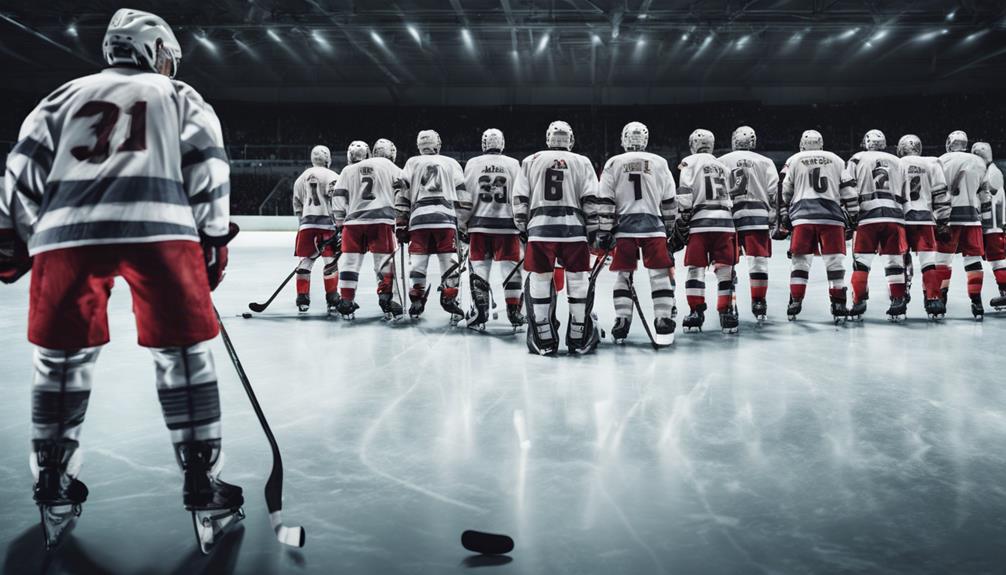In the realm of ice hockey, the composition of a team is a crucial element that can significantly impact game dynamics. The number of players on the ice at any given time is a fundamental aspect that shapes the strategies and tactics employed by teams.
Understanding the rationale behind the specific player count can shed light on the intricacies of this fast-paced sport. As we explore the considerations behind how many players are allowed on an ice hockey team, we begin to unravel the strategic implications that this decision holds for both offensive and defensive play.
History of Ice Hockey Team Sizes
Throughout the evolution of ice hockey, the sizes of teams have undergone significant changes, reflecting the sport's development and strategic adaptations. Initially, when organized leagues began forming in the late 19th century, teams consisted of seven players per side.
As the sport gained popularity and league regulations evolved, the number of players on the ice increased to eight in the early 1900s. However, by the 1911-1912 season, the standard team size was reduced to six players per side, a configuration that remains the norm in today's professional leagues.
These adjustments in team sizes were influenced by factors such as game pace, player safety, and strategic considerations, shaping the dynamics of modern ice hockey matches.
Number of Players on Ice
The standard number of players on the ice in professional ice hockey matches is six per team. This includes five skaters and one goaltender.
Player rotations are crucial in ice hockey to maintain the team's energy levels and strategic positioning. Coaches often implement line changes to keep players fresh and capitalize on specific matchups against the opposing team. These line changes occur frequently throughout the game and are a fundamental aspect of gameplay.
Understanding when to make these changes can be the difference between success and missed opportunities on the ice. With only six players per team allowed on the ice at a time, effective player rotations and timely line changes are essential for a team's performance in ice hockey.
Positions in Ice Hockey
In professional ice hockey matches, players are strategically positioned in specific roles known as positions, each serving a distinct purpose in the team's overall gameplay. These player roles are crucial for a balanced and effective team performance.
The three main player positions in ice hockey are forwards, defensemen, and goaltenders. Forwards are responsible for scoring goals and creating offensive plays, while defensemen focus on protecting their own net and setting up offensive opportunities. Goaltenders, on the other hand, defend the net from incoming shots.
Teams often use different defensive formations, such as the traditional box formation and the more modern diamond formation, to protect against opposing attacks. Understanding these positions and defensive strategies is essential for a cohesive and competitive ice hockey team.
Substitutions and Bench Players
Effective team management in ice hockey involves strategic substitutions and utilization of bench players to maintain high performance levels throughout the game. Coaches often implement specific bench rotations to keep players fresh and ensure optimal performance on the ice.
Player substitutions are crucial for adapting to the flow of the game, matching up against opponents effectively, and providing rest for fatigued players. By carefully managing bench players and making timely substitutions, teams can capitalize on different player strengths, maintain energy levels, and adjust strategies as needed.
This dynamic approach to player utilization not only maximizes team efficiency but also fosters a sense of unity and collaboration among team members, enhancing overall performance on the ice.
Power Plays and Penalty Kills
Strategically executing power plays and penalty kills is essential for maintaining momentum and defensive stability in ice hockey games. Special teams advantages are pivotal in shifting the game's dynamics in favor of a team.
When a player is sent to the penalty box, tactics become crucial in defending against the opposing team's power play. To maximize the advantage during a power play, quick puck movement and effective positioning are key.
Penalty kills require strong communication and disciplined play to thwart the opposing team's attempts to score. Understanding the nuances of special teams play can be a game-changer in tight matchups, making the difference between a win and a loss on the ice.
Strategies for Team Composition
When considering strategies for team composition in ice hockey, the focus shifts towards assembling a cohesive roster that maximizes player strengths and complements the overall game plan.
Line combinations play a crucial role in creating effective on-ice chemistry among players, allowing for seamless transitions and coordinated plays. Understanding player chemistry is key to developing strategic partnerships that can significantly impact game outcomes.
Moreover, roster depth is essential for sustaining performance throughout a grueling season, enabling coaches to adapt to injuries or matchup challenges effectively. Investing in player development not only strengthens the current roster but also ensures a pipeline of talent for future success.
Frequently Asked Questions
What Are the Regulations Regarding Goalie Substitutions in Ice Hockey?
In ice hockey, regulations for goalie substitutions emphasize safety and fairness. Goalies must adhere to equipment standards to protect themselves and maintain game integrity. Performance statistics are crucial in determining when substitutions are needed to optimize team success.
How Do Injuries During a Game Affect a Team's Ability to Make Substitutions?
Injured players during an ice hockey game can disrupt team dynamics by limiting substitutions. These instances challenge coaches to adjust strategies, test depth, and maintain player morale. Adapting quickly to injuries is crucial for seamless gameplay.
Are There Any Restrictions on the Number of Players From Each Position That Can Be on the Ice at the Same Time?
Player rotations in ice hockey are fluid, allowing for position flexibility. Coaches strategize based on game situations, often balancing offensive and defensive players on the ice simultaneously. This approach maximizes team performance and adaptability during play.
How Do Teams Strategize Their Power Play and Penalty Kill Lineups?
How do teams strategize their power play and penalty kill lineups? From face off strategies to player rotations, teams meticulously plan offensive zone tactics and defensive pairings to capitalize on opportunities and defend against threats.
Are There Any Specific Rules Regarding the Use of Backup Goalies in Ice Hockey Games?
In ice hockey games, backup goalie strategies are crucial for success. Coaches must carefully plan goalie rotation tactics to optimize performance. Specific rules may govern when and how a backup goalie can enter the game, ensuring fair play and strategic decisions.









